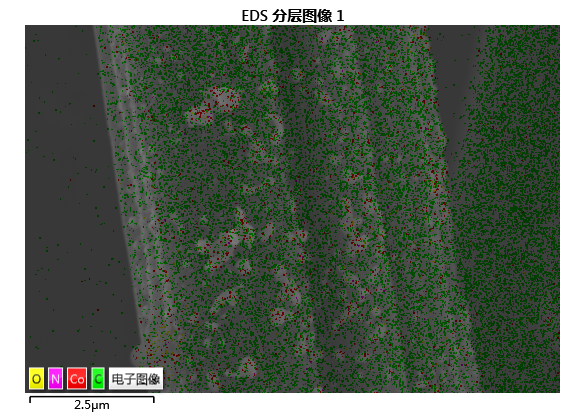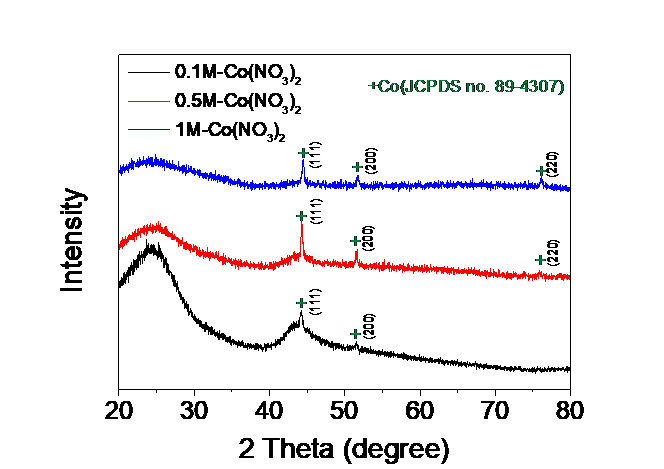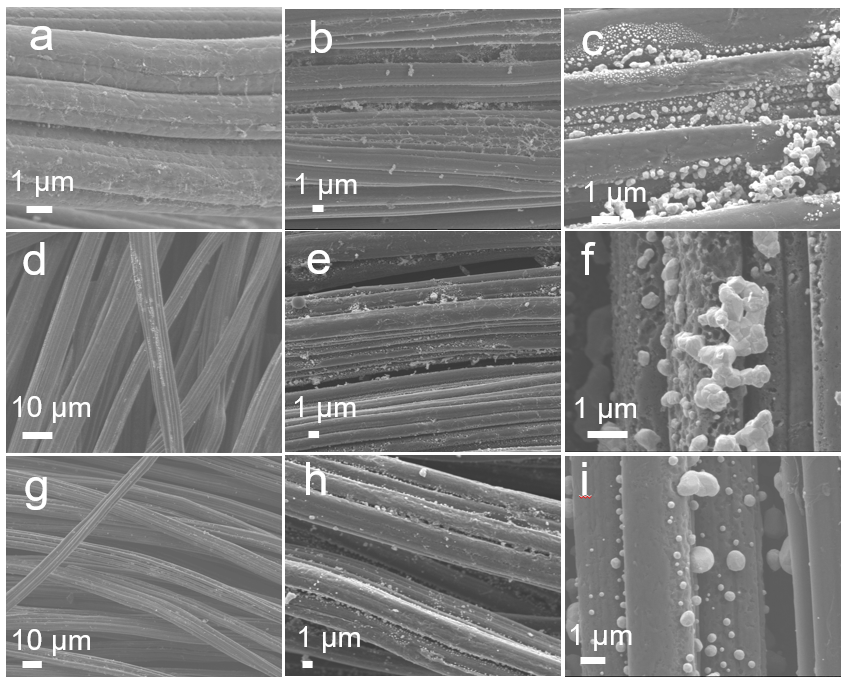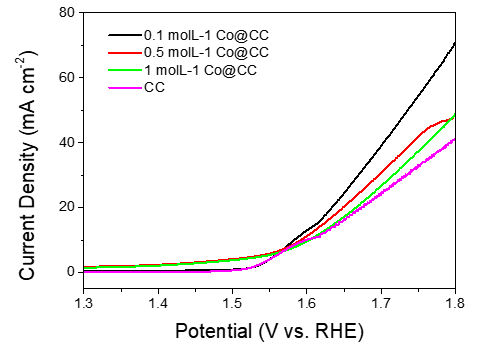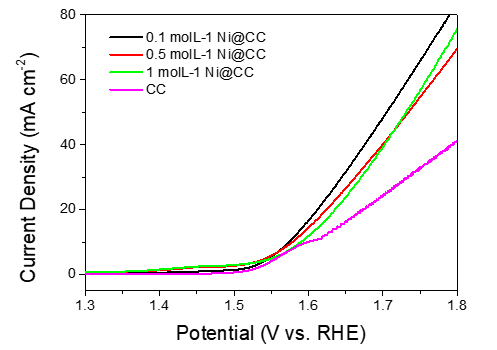碳铁基复合材料可控构建与电化学性能研究毕业论文
2020-04-25 19:45:21
摘 要
二十一世纪以来,便携式电子、智能穿戴概念快速兴起,柔性电子器件,如柔性电子传感器、柔性显示器、健康监测设备和便携式能量存储设备等快速发展,基于传统能量转换和储能的设备在柔韧性上将面临更多的挑战。柔性碳基材料以其良好的机械塑韧性、抗压抗拉性、高能量密度和高循环稳定性被视作新一代的电子器件柔性基底材料,然而其在表面功能化修饰方面还存在着很多困难。本文采用了一种直接热解法来处理,通过用硝酸铁、硝酸镍等金属硝酸盐溶液处理柔性碳基材料,然后在管式炉中直接高温热解,得到表面功能化修饰纳米颗粒的柔性碳基材料。
通过对材料高温热解修饰前后的表面形貌进行表征分析,SEM图显示原来光滑的柔性碳基材料表面在反应后出现纳米颗粒附着,对表面颗粒进行表征分析,Mapping图表明材料表面的颗粒基本上是对应的金属元素,XRD图也进一步印证负载的颗粒是金属颗粒Co、Ni、Cu和Fe3C;此外,将表面附着硝酸镍的碳布与三聚氰胺固体粉末置于管式炉中进行热解和气相沉积,通过对反应前后材料进行表征分析,SEM图显示原来表面光滑的柔性碳基材料原位生长碳纳米管,XRD图表明碳纳米管是由金属颗粒镍诱导产生并在碳布表面生长延长;循环伏安法测试表面修饰功能纳米颗粒的碳布材料,发现功能化修饰后的碳布在ORR和OER方面表现出更优异的电催化性能,并且在一定范围内,负载纳米颗粒Co、Ni的碳布材料ORR性能随着附着颗粒的量增加而增加,负载纳米颗粒Co的OER性能随着附着颗粒的量减少而增加。
关键词:界面修饰 碳基复合 碳布 功能纳米粒子 电催化
Preparation and Electrochemical Application of Flexible Carbon Matrix Composites
Abstract
Since the 21st century, the concept of portable electronics and smart wear has risen rapidly. Flexible electronic devices such as flexible electronic sensors, flexible displays, health monitoring devices and portable energy storage devices have developed rapidly. Devices based on traditional energy conversion and energy storage are flexible. Sex will face more challenges. Flexible carbon-based materials are regarded as a new generation of flexible substrate materials for electronic devices due to their good mechanical and plastic toughness, compressive and tensile properties, high energy density and high cycle stability. However, there are still many surface functionalization modifications. difficult. In this paper, a direct pyrolysis method is used to treat the flexible carbon-based materials by using a metal nitrate solution such as iron nitrate or nickel nitrate, and then directly pyrolyzed in a tube furnace to obtain the flexibility of the surface functionalized modified nanoparticles. Carbon based materials.
The surface morphology of the material before and after high temperature pyrolysis modification was characterized. The SEM image showed that the surface of the original smooth flexible carbon-based material appeared after the reaction, and the surface particles were characterized. The Mapping diagram showed that the surface of the material was basically The above is the corresponding metal element, and the XRD pattern further confirms that the supported particles are metal particles Co, Ni, Cu and Fe3C; in addition, the carbon cloth with nickel nitrate adhered on the surface and the melamine solid powder are placed in a tube furnace for pyrolysis and Vapor deposition, by characterization of the material before and after the reaction, SEM image shows the original surface of the flexible carbon-based material in situ growth of carbon nanotubes, XRD image shows that carbon nanotubes are induced by metal particles nickel and extended on the surface of carbon cloth Cyclic voltammetry was used to test the carbon cloth material of surface-modified functional nanoparticles. It was found that the functionalized modified carbon cloth exhibited superior electrocatalytic performance in ORR and OER, and within a certain range, loaded nanoparticles Co, Ni The ORR performance of the carbon cloth material increases as the amount of attached particles increases, and the OER performance of the loaded nanoparticle Co follows The amount of the particles decreases.
Key words: interface modification; carbon-based composite; carbon cloth; functional nanoparticles; electrocatalysis
目录
摘要 I
Abstract II
目录 IV
第一章 绪论 1
1.1 背景 1
1.2 柔性基底材料 1
1.2.1 柔性基底的定义和分类应用 1
1.3 柔性碳基材料研究背景 2
1.3.1 柔性碳基材料分类 3
1.3.2 柔性碳基材料的界面修饰材料 3
1.3.3 柔性碳基材料的电化学应用 4
1.4 碳纤维布 5
1.4.1 柔性碳布界面修饰结构 5
1.4.2 柔性碳布界面修饰方法及分析 6
1.5 空气电池与双功能电催化剂 8
1.5.1 贵金属双功能催化剂研究现状 9
1.5.2 非贵金属双功能催化剂研究现状 10
1.5.3 非金属双功能催化剂研究现状 10
1.6 总结与展望 11
第二章 实验部分 12
2.1 实验药品 12
2.2 实验仪器 12
2.3 制备方法 13
2.3.1 热解法表面修饰功能纳米颗粒的柔性碳基材料制备 13
2.3.2 原位生长金属纳米颗粒@碳纳米管的制备方法 13
2.4 表面修饰功能纳米颗粒的柔性碳基材料的表征与性能的测定 13
2.4.1 表面修饰材料结构形貌的表征 13
2.4.2 材料元素分布分析 14
2.4.3 材料的晶相结构分析 14
2.4.4 材料的电化学性能测试分析 14
第三章 实验结果与分析 15
3.1 柔性碳基材料表面热解法修饰Fe、Co、Ni、Cu的分析 15
3.1.1 热解法修饰柔性碳基材料的表征 15
3.1.2 不同初始硝酸盐浓度对柔性碳基材料表面修饰情况对比 18
3.1.3 不同初始硝酸盐浓度对柔性碳基材料表面修饰后的电化学分析 20
3.2 柔性碳基材料表面生长碳纳米管的分析 24
3.2.1 气相沉积法制备的碳纳米管的表征 24
第四章 结论、成果及展望 26
4.1 结论 26
4.2 成果 26
4.3 展望 26
参考文献 27
致谢 31
绪论
背景
柔性可拉伸的电子产品将广泛应用于如可穿戴设备,机器人技术和生物医学等领域。然而随着柔性电子技术的发展,人们对电子设备在可适应型柔性方面的要求也越来越多,例如传统的不可弯曲手机渐渐需要往柔性可折叠方向发展。因此,传统的柔性储能器件在更加灵活的柔韧性和材料器件的性能方面迎来更多的挑战和机遇。新一代的电子器件不仅需要满足器件自身轻薄的特点,而且需要良好电化学性能。目前众多器件例如柔性超级电容器、柔性离子电池、柔性催化电极和柔性太阳能电池等[1]都向着更柔更轻的方向发展。其中,良好的机械塑韧性、抗压抗拉性、高能量密度和高循环稳定性等特点是设计和制造这类柔性能量转换和储存设备的关键。目前广泛使用的柔性基底材料有金属薄片、导电聚合物和柔性碳基材料等,其成本高、加工困难且超过一定曲率就会出现材料的导电性不可逆损失。设计一种低成本、易加工并具有良好的机械性能和优异的电学性能的柔性材料是目前科学家们研究的重点。
柔性基底材料
柔性电子器件的迅速发展离不开器件各个部位的发展创新,基底材料往往是决定器件柔韧性和是否轻薄的关键,目前很多科学家都在研究兼具优异机械性能和轻薄特征的导电基底材料,这也将给柔性电子器件领域提供基础。
柔性基底的定义和分类应用
柔性基底材料是指具备一定柔性可用作基底的材料,在外力作用下会发生相应形变并且适当形变后基底材料固有性质不会发生改变,仍可以通过再次形变恢复到初始状态。电子器件中的柔性基底材料不仅具备良好的导电性和耐腐蚀性而且在抗压抗拉性、机械塑韧性方面也有很好的表现,发生一定形变后的器件仍能够恢复原有状态,并且不改变其电学性质,表现出一定的机械性能和化学稳定性。
目前常见的柔性基底材料主要有以下几类:柔性金属材料、导电高分子复合材料和柔性碳基材料等。
相关图片展示:
